Here is a fun fact: The only new Acura – besides the NSX supercar – that comes standard with more than a four cylinder engine under its hood isn’t a car.
It’s the MDX – which is a three-row crossover SUV.
It comes standard with the last V6 Acura installs as standard equipment in anything else except the NSX (the Type-S variant of the new TLX sedan is available with a V6, at extra cost).
It used to be you could get a V6 in Honda cars – like the Accord sedan. But the government is making it harder and harder to offer more-than-fours in anything, including even large crossovers like the MDX that cost twice as much as Honda cars.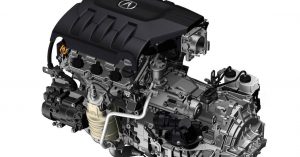
A growing number of the others in this class come standard with fours – including MDX cross-shops like the Genesis GV80 and the Mercedes-Benz GLE.
And some large crossovers are four-cylinder-only, like the Subaru Ascent.
So, the fact that the MDX still comes standard with a V6 is heart-warming news – even if it’s sad news that it is the last Acura that comes with one for less than $50k .
What It Is
The MDX is a mid-sized, luxury-brand crossover that comes standard with third row seating (it’s optional in several rivals, including the Lexus RX350 and Benz GLE) a huge panorama sunroof, built-in smartphone charger and Alexa – Amazon’s voice-command virtual assistant. Plus a 3.5 liter V6 engine, which was a given thing as recently as five or so years ago in this class but which is becoming a rare or hugely extra-cost thing.
Prices start at $46,900 for the base front-wheel-drive trim; with Acura’s Super Handling All-Wheel-Drive (SH-AWD) system, the price rises to $48,900.
There is also an A-Spec version, which gets sportier exterior and interior cosmetic touches, including perforated suede sport seats with bun coolers and warmers, a cabin intercom system and an excellent 16 speaker, 710 watt ELS audio rig.
A Technology Package is available for the base trim; it includes 20-inch wheels, rain-sensing wipers, leather seats and rear window sunshades, among other items. A-Spec trims can be ordered with this package and an Advance package that includes a Heads-Up Display, a surround-view camera system, heated steering wheel, hands-free rear liftgate and remote (via key fob) engine starting.
The Advance package however is restricted to A-Spec trims, which also come standard with the SH-AWD system.
What’s New
After a year’s absence – there was no 2021 MDX – a larger, longer and roomier ’22 MDX debuts. It has a revamped suspension underneath (including a new-design double wishbone suspension up front) and updated styling outside and in, new tech features and – by the grace of the Motor Gods – Acura’s superb 7,000 RPM-capable 3.5 liter DOHC V6, which returns as standard equipment in all trims.
It’s paired with a new ten speed automatic transmission, replacing the nine speed automatic used in the previous generation MDX.
Get it while you still can.
What’s Good
The V6 hasn’t been replaced by a turbo’d four.
Many premium features – such as the panorama sunroof, a configurable LCD main gauge cluster and a 12.3 inch LCD display for the infotainment system – are included in the MDX’s extremely competitive under-$47k base price.
A much bolder look on the outside – and noticeably more room for people and cargo on the inside.
What’s Not So Good
V6 doesn’t have the low-end lazy torque produced by the turbo fours that are supplanting V6s in practically everything.
Some premium features – like the heated steering wheel – are only gettable if you get the A-Spec trim and then buy the Advance package, which bundles it with other features you may not want or – rather – might prefer not to have to buy in order to get the one thing you want.
Modest for the class (5,000 lbs.) max tow rating.
It is a sad signpost on the road we’re currently traveling that Honda’s brilliant 3.5 liter V6 no longer comes standard in any of the cars made by Acura, which of course is Honda’s luxury line.
But thankfully, it is still standard in the MDX – where it makes 290 horsepower.
It makes it without the combustion-engine equivalent of steroids; i.e., a turbo, which boosts the output of what would otherwise be too small an engine for the size and weight of the vehicle.
Turbos have their merits but they also add parts – and pressure. Both of which come with additional costs, actually and potentially. There’s a reason why the MDX is one of the best deals going in this class. Acura can sell it for less because it costs less to build a V6 (without a turbo) than a four with one.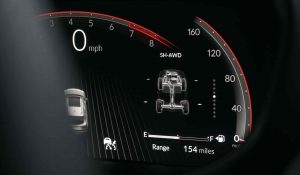
Or a turbo’d V6, for that matter – as you’ll find under the hood of the Lincoln Aviator, another mid-sized, three-row cross shop.
The Lincoln’s 3.0 liter V6 is a kind of in-between the turbo’d 2.5 liter (300 horse) four that’s standard in Genesis GV80 and the 3.5 liter V6 that’s standard in the Acura. The boost makes up for the size – and considerably so. The Aviator’s V6 summons a class-mightiest 400 standard horses. But, you’ll pay an equally mighty $4,200 more than the MDX’s base price ($51,000 less $46,900) for the additional 110 hooves.
The turbo four Genesis also costs more – though not as much more.
Its base price – with the 2.5 liter turbo’d four – is $48,900 (vs. the Acura’s base price of $46,900). The GV80’s optional turbo V6 – which produces 375 horses – also punches up the starting price of this one to $59,650 (a difference of $12,750).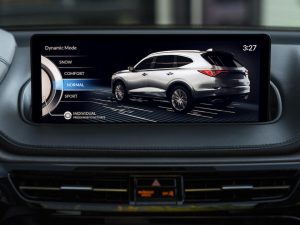
The Lexus RX350 comes standard with a 3.5 liter, 295 horsepower V6 (no turbo) and it costs less than the Acura, just $45,200 to start. But it does not come standard with three rows of seats. Third row seating is available – in the slightly larger RX350L – for $48,000 to start ($1,100 more than the base price of the MDX).
The sad-sack Benz GLE comes standard with a 2.0 liter turnbo’d four that only manages 255 horsepower, a third row costs extra – and the base price of the four cylinder/five-passenger Benz is $54,750.
The wait-and-see is the not-yet-available but almost-here 2022 Infiniti QX60, which will have a standard third row and a standard 3.5 liter, 295 horsepower V6 without turbos, very much like the MDX. It will reportedly sticker for around $46,000 to start, which would make it the most affordable premium-brand three-row crossover with standard V6 power.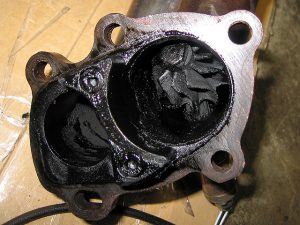
But the take-home point here is that V6-equipped models like the MDX (and the Q and the Lexus RX) cost less than their turbo’d brethren, which is an indictment of sorts of turbocharging smaller engines as a way to reduce fuel consumption and so what one spends on fuel. Which doesn’t matter a whole bunch if you spend more on the vehicle – both to buy it and (potentially) to fix it, which pressurizing a small engine to inflate its output to that of a larger, but less pressured engine tends to do. Just as shooting ‘roids makes it more likely a weightlifter will eventually bust a vein.
Speaking of fuel economy. . .
The front-drive version of the MDX rates 19 city, 26 highway – essentially the same mileage advertised by the turbo-four-powered Genesis GV80 (21 city, 25 highway) and better than the 21 city, 24 highway posted by the turbo four-powered VW Atlas, which also only offers up 235 horsepower.
But . . .
There is a catch.
Because there is no turbo, there is less low-RPM torque. The MDX’s V6 produces a relatively (relative to the turbo’d competition) 267 ft.-lbs. and does not produce it until you get the engine revving to 4,700 RPM.
To put that in some context, the Genesis GV80’s turbo four generates 311 ft.-lbs. at just 1,650 RPM.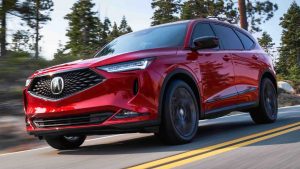
To understand what that means, it’s necessary to take a drive.
On The Road
Before there were Acura crossovers – or crossovers, at all – there were Acura sport sedans like the Integra, if anyone remembers. These had fours – without turbos, usually – that begged to be revved. The Integra’s VTEC four could spin to almost 8,000 RPM but it only made 128 of.-lbs. of torque – and not until it was spinning north of 6,000 RPM.
But it was a joy to spin that thing. And to hear it. You just had to work it.
The same tradition carries over to the MDX. Its V6 is also a revver – to north of 7,000 RPM – and you’ll love the sounds it makes on the way. No turbo’d four can match that, no matter how much low-RPM grunt it makes.
But you do have to work it – which is something some people may not appreciate.
There are other crossovers for them. It’s not a question of better – or worse. Rather of difference – and we could use some more of that in the crossover class.
Acura provides it.
The ten speed automatic has one more overdrive gear than the old nine speed transmission, which is there to help keep the V6 it’s bolted to under the hood of the MDX – by increasing its MPGs. The third (and last) overdrive ratio – 10th gear – is an astounding .52 ratio (.67 or so is typical). This dramatically cuts the revs when the engine isn’t being revved – as when steady-state cruising at 70 or so, at which road speed the engine speed is a nice and quiet – and sufficiently fuel-efficient – 2,000 or less RPM.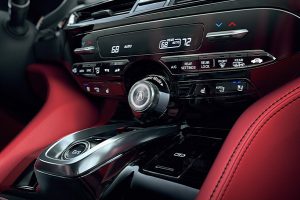
Some modern automatics are deliberately programmed to upshift soon – and stubbornly stay upshifted unless you really insist, as by putting your right foot down, hard. Honda (whoops, Acura) does a better-than-most job of balancing the need to keep the government happy while also keeping the person behind the wheel – and making the payments – happy.
There are the usual driver-selectable modes but your best bet for keeping that V6 singing is to use the manual-control paddle shifters, though Sport (push the S/D button) will lock out the overdrive on top and sharpen up the gear changes below.
Acura says the new double-wishbone front suspension, increased wheelbase (113 inches now, up from the previous-gen MDX’s 110 inches) and widened track greatly improves handling and road feel, which it probably does but what you really notice from behind the wheel is the longer hood and feeling of increased substantiality – a hard-to-articulate but no less real thing, like the better vibe you get at your favorite spot vs. some other spot.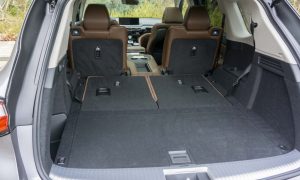
It is not as mighty-feeling as some of the others in the segment, like the Lincoln Aviator and the turbo V6 version of the Genesis GV80. But it has a feeling you won’t find in those – again, not that it’s better or worse.
But it is . . . different.
And that’s important given how same-same crossovers can be.
At The Curb
The new MDX is also longer, itself – not just the hood and not just the wheelbase. It is now 198.4 inches end to end vs. the previous-gen MDX’s 196.2 inches. That edges it closer to full-sized and certainly makes it competitive with full-sized crossovers, in terms of the room you’ll find inside. Especially in terms of back seat and third row legroom and cargo room.
The old MDX had a fairly tight second row, with 36.6 inches of legroom back there. The ’22 MDX ups that to 38.5 inches and those extra inches also make the third row more roomy, by making more room for it.
And there’s more room behind it, too. Cargo space with the third row up is now 18 cubic feet, up from 15 cubic feet previously and the total available cargo space with the second and third rows folded has been expanded to 95 cubic feet, a huge uptick from the old MDX’s 68.4 cubic feet.
This is considerably more space for cargo than the otherwise very appealing Lincoln Aviator offers (77 cubic feet) and also edges out the Genesis GV80, which – like the standard-issue Lexus RX350 – only offers seats for five.
There are also some thoughtful, practical touches – including charger ports shaped for all devices housed (up front) in a pop-up that remains hidden on the center console unless you push it to open it and a hand rest made to look like the grab-handle gear selector that isn’t there anymore – because you select gears in the MDX by pushing buttons.
And as “tech” as this Acura is, it still also comes with a 12 volt power point – essential if you happen to have a radar detector . . .
The Rest
The MDX’s LCD screen is not a touchscreen, which means you have to use the trackpad on the center console. It suffers from the inherent problem that all such systems suffer from in a moving vehicle: As the car moves, so does your finger, which then “over-writes” the track you were aiming for. Acura does improve this inherently problematic system with better-than-most pressure sensitivity as well as haptic feedback, but there is still no functional substitute for knobs and switches that you can’t over-write and which you can more easily operate by feel, without having to look.
Acura puts Alexa – the AI question-answerer developed by Amazon – in every MDX. It can be handy, if you have a question and it can be more safely answered than by vocalizing it than by trying to peck it on your smartphone while you’re driving. But there is also an oogly aspect to having Jeff Bezos riding shotgun with you – and perhaps taking note of what you might be questioning.
Supposedly, Alexa’s ears are closed until you ask her – specifically – a question. But in order for her to answer, she has to be listening. All the time. What is else she hearing? We know that when she is in our homes, she sometimes hears things we didn’t ask her to listen in on.
The same is going on in our cars now.
It’d be nice if that were optional.
On the upside, many of the things that are optional in others in the class aren’t in this Acura – like the huge panorama roof, for instance. Every MDX comes with it, standard. And for well under $50k, sticker – with the V6.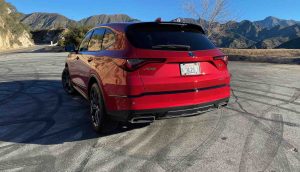
On the downside, a loaded MDX with the SH-AWD system and the Technology and Advanced packages can price out well over $60k, which makes it a harder swallow vs. more powerful rivals like the Aviator that cost less with more engine – if not quite as much room (or revs).
Still, the MDX is without doubt one of the best deals going – without giving up much, if anything.
As well as something different, for a change.
PS: A high-powered Type S variant of the MDX is coming. It should close the power/performance gap between this Acura and the Aviator – while opening it up relative to the rest.
The Bottom Line
If Alexa could be kicked to the curb, it’d be hard not to want to have this Acura in the garage.
. . .
Got a question about cars, Libertarian politics – or anything else? Click on the “ask Eric” link and send ’em in!
If you like what you’ve found here please consider supporting EPautos.
We depend on you to keep the wheels turning!
Our donate button is here.
If you prefer not to use PayPal, our mailing address is:
EPautos
721 Hummingbird Lane SE
Copper Hill, VA 24079
PS: Get an EPautos magnet or sticker or coaster in return for a $20 or more one-time donation or a $10 or more monthly recurring donation. (Please be sure to tell us you want a magnet or sticker or coaster – and also, provide an address, so we know where to mail the thing!)
My eBook about car buying (new and used) is also available for your favorite price – free! Click here. If that fails, email me at EPeters952@yahoo.com and I will send you a copy directly!




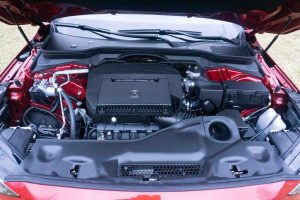








i had last year of RDX with v6, it was fun to drive 🙂
I’m looking at a $50k vehicle and yawning.
From the back & sides I have no idea what car I’m looking at.
The only plus to this is it doesn’t have a tiny turbo.
‘The Aviator’s V6 summons a class-mightiest 400 standard horses. But, you’ll pay an equally mighty $4,200 more than the MDX’s base price for the additional 110 hooves.’ — EP
Anatomically speaking, those 110 extra horses would have 440 hooves.
Not that there’s much tangible connection between an Acura MDX and a horse-drawn carriage of 120 years ago (or an Amish buggy today).
Ironically, a male-voiced Alexa actually could power a Turing-test-capable talking horse such as Mister Ed, of the 1960s TV show.
Wikipedia offers a strangely pertinent commentary:
‘Mister Ed’s ability to talk was never explained and rarely contemplated on the show. In the first episode, when owner Wilbur Post expresses an inability to understand the situation, Mister Ed offers the show’s only remark on the subject: “Don’t try. It’s bigger than both of us!”
So true, Mister Ed, of both your quadripedal self and your wayward descendant, the disembodied Alexa.
Hi Jim,
Mister Ed… good memories…. of a better, vanished time…. sigh.